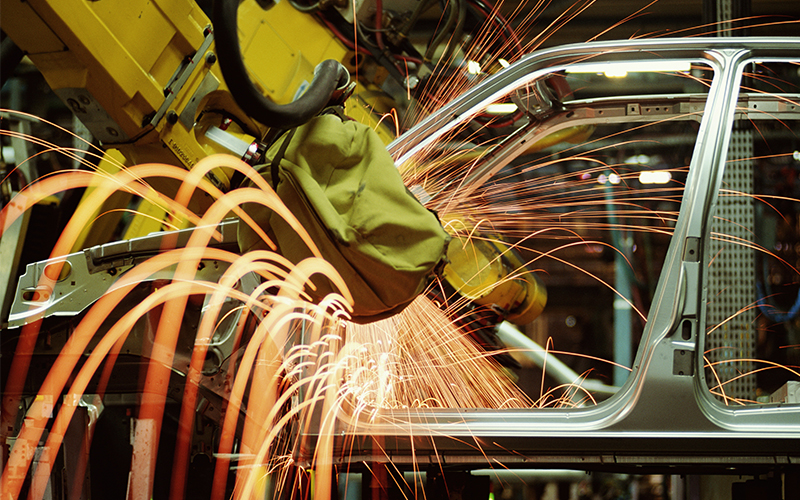manufacturing
Impact of industrial revolution 4.0 on manufacturing
The manufacturing industry has been through three industrial revolutions. The first industrial revolution in the 18th century introduced steam power to replace manual work for factory manufacturing. The second industrial revolution in the 19th century introduced assembly lines and electric power in factories. Computers, advanced telecommunications, robots, etc., marked the third industrial revolution in the 20th century. And now, in the 21st century, the fourth industrial revolution, called industry 4.0, is taking place.
A brief look at industry 4.0
The term originated in Germany in 2011 for a combination of advanced technologies to be used in manufacturing. The underlying four principles of industry 4.0 are:
- Interconnection
- Information transparency
- Technical assistance
- Decentralised decisions
Many advanced technologies integrate to improve supply chain management, product design, manufacturing processes, delivery and distribution, and even maintenance. The idea is to make smart manufacturing through the creation of smart factories. So, which are the technologies enabling this revolution in the manufacturing sector?
Key technology enablers of industry 4.0
Internet of Things (IoT):
IoT is a key technology component enabling smart manufacturing. All machines on the factory floor get equipped with sensors that allow them to connect to other devices required to enable data collection, analysis, and further processing. The insights from this data analysis help better decision-making. Better decisions coupled with Robotic process automation solutions in ERP, supply chain, customer service, and other enterprise applications, will enhance end-to-end operational efficiency.Cloud computing:
The gigantic amounts of data generated from sensor-connected factory devices need humongous storage capacities with appropriate security and data management capabilities. Cloud computing has splendid processing capabilities with offerings like BPAAS analytics, even for geographically distributed systems, and is cost-effective. This aspect makes it accessible and efficient for manufacturers of all sizes.AI and machine learning (ML):
This data collection will deliver desired results only when we can generate actionable insights to drive decisions. AI and ML make it possible by helping automate workflows and providing visibility and predictability to improve operational efficiency through offerings such as spend visibility solutions.Edge computing:
Edge computing is the computing that happens at the network data point where the data gets generated. This point is referred to as the edge. Real-time operations may require some analysis locally to minimise latency. Smart sensors backed by edge computing capabilities can locally process inputs to enable immediate actions.Cybersecurity:
Smart factories connected to the Internet must have cybersecurity. As much as interconnectedness enables smartness, it also opens the doors for cyber attacks that need cybersecurity for prevention.In what way do these technologies impact the manufacturing industry?
IoT integration and data collection:
The most significant change industry 4.0 will bring to manufacturing is the installation of IoT sensors on all devices and machines. These sensors facilitate real-time monitoring and data collection on the factory floor. Manufacturers can use the insights from this data analysis to tap their complete ecosystem for decision-making in sales, supply chain processes, people management, new market expansion, and more.Real-time monitoring:
Sensor-equipped devices upgrade monitoring from manual to automatic, raising the safety standards on the factory floor. Advanced technologies like 4G and 5G ensure that cloud-based monitoring is possible from anywhere using a smartphone. The integrated AI and ML applications will generate insight-based alerts to minimise downtime through predictive maintenance.Enhanced automation:
Industrial robotic automation has been around for some time now. However, industry 4.0 will increase automation levels through better use of AI and ML because of access to more data due to interconnectedness. It will fuel innovation to achieve higher productivity, enhanced designs, and better quality products and generate better value for customers while ensuring higher ROI for manufacturers.What benefits will manufacturers gain from these changes heralded by industry 4.0?
According to a Business Development Bank of Canada (BDC) survey, most manufacturers who are early adopters of industry 4.0 are experiencing these benefits. The supporting data points indicate that among the early adopters 60% saw productivity increase, 50% saw lower operational costs, 42% enjoyed the benefits of improved product quality and 13% experienced higher innovation.
The study quoted these adopters as twice as likely to report 10% or more revenue growth, giving them an edge over non-adopters. A few studies have indicated productivity can go higher by 18% in some sectors. Also, manufacturers can produce more goods in less time with optimised personnel. Many industry reports have highlighted the financial impact of unexpected manufacturing downtime running into millions. Predictive maintenance will significantly reduce this. Advanced technologies like Digital Twin simulations, Augmented Reality (AR), Additive Manufacturing (AM), etc., help improve product quality. Predictive demand forecasts help manufacturers avoid surplus production and also achieve faster time-to-market. Additionally, material and maintenance cost reduction positively impacts ROI.
These factors will automatically lead to higher revenues and better profitability. It also results in better customer experiences. Perhaps, it is not surprising that the global industry 4.0 market size is expected to reach USD 165.5 billion by 2026. And with more technological advances, we can envisage it getting bigger and better.
*For organizations on the digital transformation journey, agility is key in responding to a rapidly changing technology and business landscape. Now more than ever, it is crucial to deliver and exceed on organizational expectations with a robust digital mindset backed by innovation. Enabling businesses to sense, learn, respond, and evolve like a living organism, will be imperative for business excellence going forward. A comprehensive, yet modular suite of services is doing exactly that. Equipping organizations with intuitive decision-making automatically at scale, actionable insights based on real-time solutions, anytime/anywhere experience, and in-depth data visibility across functions leading to hyper-productivity, Live Enterprise is building connected organizations that are innovating collaboratively for the future.






